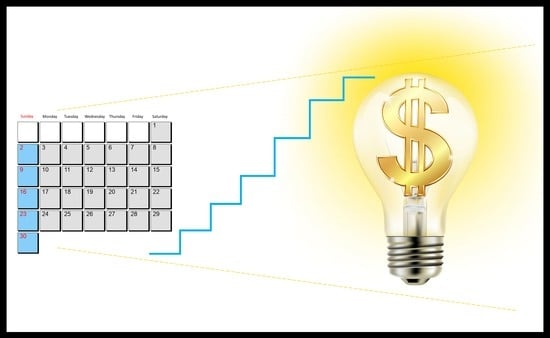Short-Term Electricity Price Forecasting Based on Similar Day-Based Neural Network
Abstract
:1. Introduction
2. Similar Days Selection
2.1. Relation Evaluation
2.2. Similarity Calculation Model
2.2.1. Model A: Refined Euclidean Norm
- is distance,
- is LMP of reference day at time ($/MWh),
- is LMP of similar day in past at time ($/MWh),
- is load of reference day at time (MW),
- is load of similar day in past at time (MW),
- is LMP of reference day at time ($/MWh),
- is LMP of similar day in past at time ($/MWh),
- is load of reference day at time (MW),
- is load of similar days in past at time (MW),
- is load deviation between reference day and similar days at time (MW),
- is load deviation between reference day and similar days at time (MW),
- is LMP deviation between reference day and similar days at time ($/MWh),
- is LMP deviation between reference day and similar days at time ($/MWh),
- is weight factor
2.2.2. Model B: Refined Manhattan Distance
2.2.3. Model C: Refined Cosine Coefficient
2.2.4. Model D: Refined Pearson Correlation Coefficient
- is average LMP of reference day at time ($/MWh),
- is average LMP of reference day at time ($/MWh),
- is average LMP of similar day in past at time ($/MWh),
- is average LMP of similar day in past at time ($/MWh),
- is average load of reference day at time (MW),
- is average load of reference day at time (MW),
- is average load of similar day in past at time (MW),
- is average load of similar day in past at time (MW).
2.3. Interval of Time Framework
2.4. Procedure of Similar Date Selection
- Step 1.
- Define a reference day which is one day before the forecasting day;
- Step 2.
- Select a proper interval of time framework, d, based on Figure 2;
- Step 3.
- Equations (2)–(5) are used to calculate the similarity between the selecting days and the reference day in LMP and load;
- Step 4.
- Sort the similarity in Step 3. Note that the (2) and (3) are dissimilarity. Nevertheless (4) and (5) are similarity;
- Step 5.
- Choose the number of similar days, N.
3. Similar Day Regression Model
3.1. Brief Review of Regression Model
3.2. Regression Model of Forecasting LMPs
- Step 1.
- Variables definition: In the regression model, the dependent variables are assumed as forecasting , and the independent variables are as , , , and ;
- Step 2.
- Weight factor analysis: Base on the LMPs and loads of similar days and the reference day, the weight factors in (6) can be analyzed;
- Step 3.
- Weight factor evaluation: The forecast is acceptable when the probability values (p value) of weight factors are smaller than 0.05. Thus, the independent variables with the P bigger than 0.05 should be removed and the remained weight factors are analyzed though step (2);
- Step 4.
- LMPs forecasting: and in (7) are the average LMP and load data respectively, which are obtained by taking an average of selected N similar days. And the forecasting price can be calculated by the obtained and .
4. Neural Network Based Forecasting Models of Similar Day
4.1. Neural Network Model
4.2. Neural Network Forecasting Model
- (a)
- Training: Selecting similar day interval, d, it is 45 days in the paper, and therefore the load and LMP data have 134 days (excluding the load and LMP of reference day.) as input training data. According to Figure 2, input training data is based on the reference date which is point A. The similar days are the d days from the day before a reference day and past d days before and after the reference day in the previous year. And during training, need to exclude the load and LMP of reference day.
- (b)
- Testing: Forecasting input data is the load and LMP of the reference day.
4.3. Forecast Accuracy
5. Comparison of Simulation Results
5.1. Regression Model Simulation Result and Comparison
5.2. Neural Network Simulation Result and Comparison
5.3. Comparison of Regression Forecasting and Neural Network Forecasting
6. Conclusions
Author Contributions
Funding
Conflicts of Interest
References
- Chitsaz, H.; Zamani, D.P.; Zareipour, H.; Parikh, P.P. Electricity price forecasting for operational scheduling of behind-the-meter storage systems. IEEE Trans. Smart Grid 2018, 9, 6612–6622. [Google Scholar] [CrossRef]
- Hubicka, K.; Marcjasz, G.; Weron, R. A note on averaging day-ahead electricity price forecasts across calibration windows. IEEE Trans. Sustain. Energy 2019, 10, 321–323. [Google Scholar] [CrossRef]
- Ranjbar, M.; Soleymani, S.; Sadati, N.; Ranjbar, A.M. Electricity price forecasting using artificial neural network. In Proceedings of the 2006 International Conference on Power Electronic, Drives and Energy Systems, New Delhi, India, 12 December 2006; pp. 1–5. [Google Scholar]
- Bissing, D.; Klein, M.T.; Chinnathambi, R.A.; Selvaraj, D.F.; Ranganathan, P. A hybrid regression model for day-ahead energy price forecasting. IEEE Access 2019, 7, 36833–36842. [Google Scholar] [CrossRef]
- Vu, D.H.; Muttaqi, K.M.; Agalgaonkar, A.P.; Bouzerdoum, A. Short-term forecasting of electricity spot prices containing random spikes using a time-varying autoregressive model combined with kernel regression. IEEE Trans. Indus. Inf. 2019, 15, 5378–5388. [Google Scholar] [CrossRef]
- González, C.; McWilliams, M.J.; Juárez, I. Important variable assessment and electricity price forecasting based on regression tree models: Classification and regression trees, bagging and random forests. IET Gener. Trans. Dist. 2015, 9, 1120–1128. [Google Scholar] [CrossRef]
- Pourdaryaei, A.; Mokhlis, H.; Illias, H.A.; Kaboli, S.H.A.; Ahmad, S.; Ang, S.P. Hybrid ANN and artificial cooperative search algorithm to forecast short-term electricity price in de-regulated electricity market. IEEE Access 2019, 7, 125369–125386. [Google Scholar] [CrossRef]
- Alanis, A.Y. Electricity prices forecasting using artificial neural networks. IEEE Lat. Am. Trans. 2018, 16, 105–111. [Google Scholar] [CrossRef]
- Mosbah, H.; El-hawary, M. Hourly electricity price forecasting for the next month using multilayer neural network. Can. J. Elect. Comp. Eng. 2016, 39, 283–291. [Google Scholar] [CrossRef]
- Voronin, S.; Partanen, J.; Kauranne, T. A hybrid electricity price forecasting model for the Nordic electricity spot market. Int. Trans. Elec. Energy Syst. 2014, 24, 736–760. [Google Scholar] [CrossRef]
- Lee, C.Y.; Tuegeh, M. Optimal optimisation-based microgrid scheduling considering impacts of unexpected forecast errors due to the uncertainty of renewable generation and loads fluctuation. IET Renew. Power Gen. 2020, 14, 321–331. [Google Scholar] [CrossRef]
- Lee, C.Y.; Tuegeh, M. An optimal solution for smooth and non-smooth cost functions-based economic dispatch problem. Energies 2020, 13, 3721. [Google Scholar] [CrossRef]
- Shrivastava, N.A.; Khosravi, A.; Panigrahi, B.K. Prediction interval estimation of electricity prices using PSO-tuned support vector machines. IEEE Trans. Ind. Inf. 2015, 11, 322–331. [Google Scholar] [CrossRef]
- Peesapati, R.; Kumar, N. Electricity price forecasting and classification through wavelet–dynamic weighted PSO–FFNN approach. IEEE Syst. J. 2017, 12, 3075–3084. [Google Scholar]
- Pourdaryaei, A.; Mokhlis, H.; Illias, H.A.; Kaboli, S.H.A.; Ahmad, S. Short-term electricity price forecasting via hybrid backtracking search algorithm and ANFIS approach. IEEE Access 2019, 7, 77674–77691. [Google Scholar] [CrossRef]
- Darudi, A.; Bashari, M.; Javidi, M.H. Electricity price forecasting using a new data fusion algorithm. IET Gener. Trans. Distr. 2015, 9, 1382–1390. [Google Scholar] [CrossRef]
- González, J.P.; Muñoz San Roque, A.M.S.; Pérez, E.A. Forecasting functional time series with a new hilbertian armax model: Application to electricity price forecasting. IEEE Trans. Power Syst. 2018, 33, 545–556. [Google Scholar] [CrossRef]
- Bello, A.; Bunn, D.W.; Reneses, J.; Muñoz, A. Medium-term probabilistic forecasting of electricity prices: A hybrid approach. IEEE Trans. Power Syst. 2017, 32, 334–343. [Google Scholar] [CrossRef]
- Khosravi, A.; Nahavandi, S.; Creighton, D. Quantifying uncertainties of neural network-based electricity price forecasts. Appl. Energy 2013, 112, 120–129. [Google Scholar] [CrossRef]
- Chang, P.C.; Fan, C.Y.; Lin, J.J. Monthly electricity demand forecasting based on a weighted evolving fuzzy neural network approach. Int. J. Elect. Power Energy Syst. 2011, 33, 17–27. [Google Scholar] [CrossRef]
- Esmaili, M.; Shayanfar, H.A.; Moslemi, R. Locating series FACTS devices for multi-objective congestion management improving voltage and transient stability. Eur. J. Oper. Res. 2014, 236, 763–773. [Google Scholar] [CrossRef]
- Bharatwaj, N.V.; Abhyankar, A.R.; Bijwe, P.R. Improved loss distribution and modeling in DCOPF. Int. J. Elec. Power Energy Syst. 2013, 53, 416–425. [Google Scholar] [CrossRef]
- Sarkar, V.; Khaparde, S.A. Reactive power constrained OPF scheduling with 2-d locational marginal pricing. IEEE Trans. Power Syst. 2013, 28, 503–512. [Google Scholar] [CrossRef]
- Lewis, G. Estimating the value of wind energy using electricity locational marginal price. Energy Policy 2010, 38, 3221–3231. [Google Scholar] [CrossRef]
- Gautam, D.; Mithulananthan, N. Locating distributed generator in the LMP-based electricity market for social welfare maximization. Electr. Power Compon. Syst. 2007, 35, 489–503. [Google Scholar] [CrossRef]
- Nozawa, T.; Konda, M.; Fujibayashi, M.; Imai, M.; Kotani, K.; Sugawa, S.; Ohmi, T. A parallel vector-quantization processor eliminating redundant calculations for real-time motion picture compression. IEEE J. Solid State Circuits 2000, 35, 1744–1751. [Google Scholar] [CrossRef]
- Bastian, J.; Zhu, J.X.; Banunarayanan, V.; Mukerji, R. Forecasting energy prices in a competitive market. IEEE Comp. Appl. Power 1999, 12, 40–45. [Google Scholar] [CrossRef]

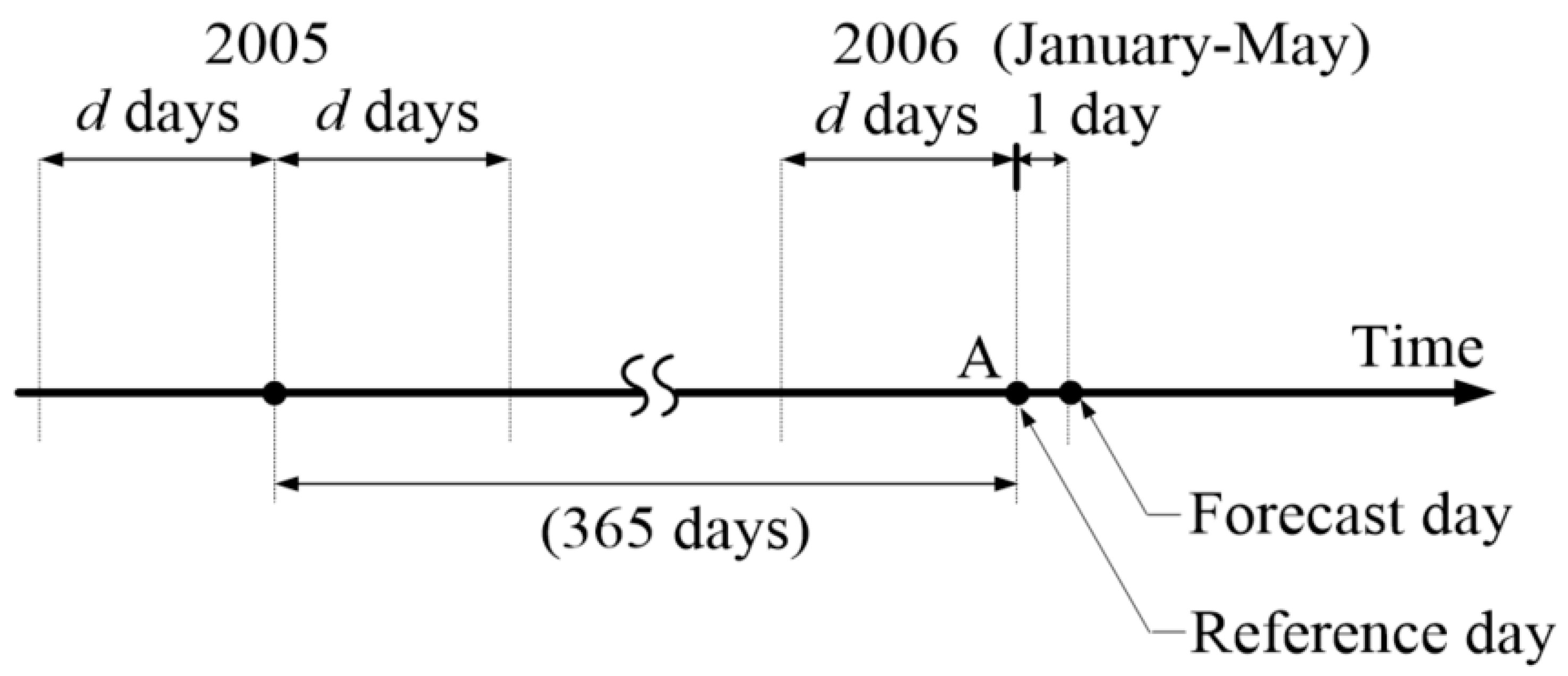
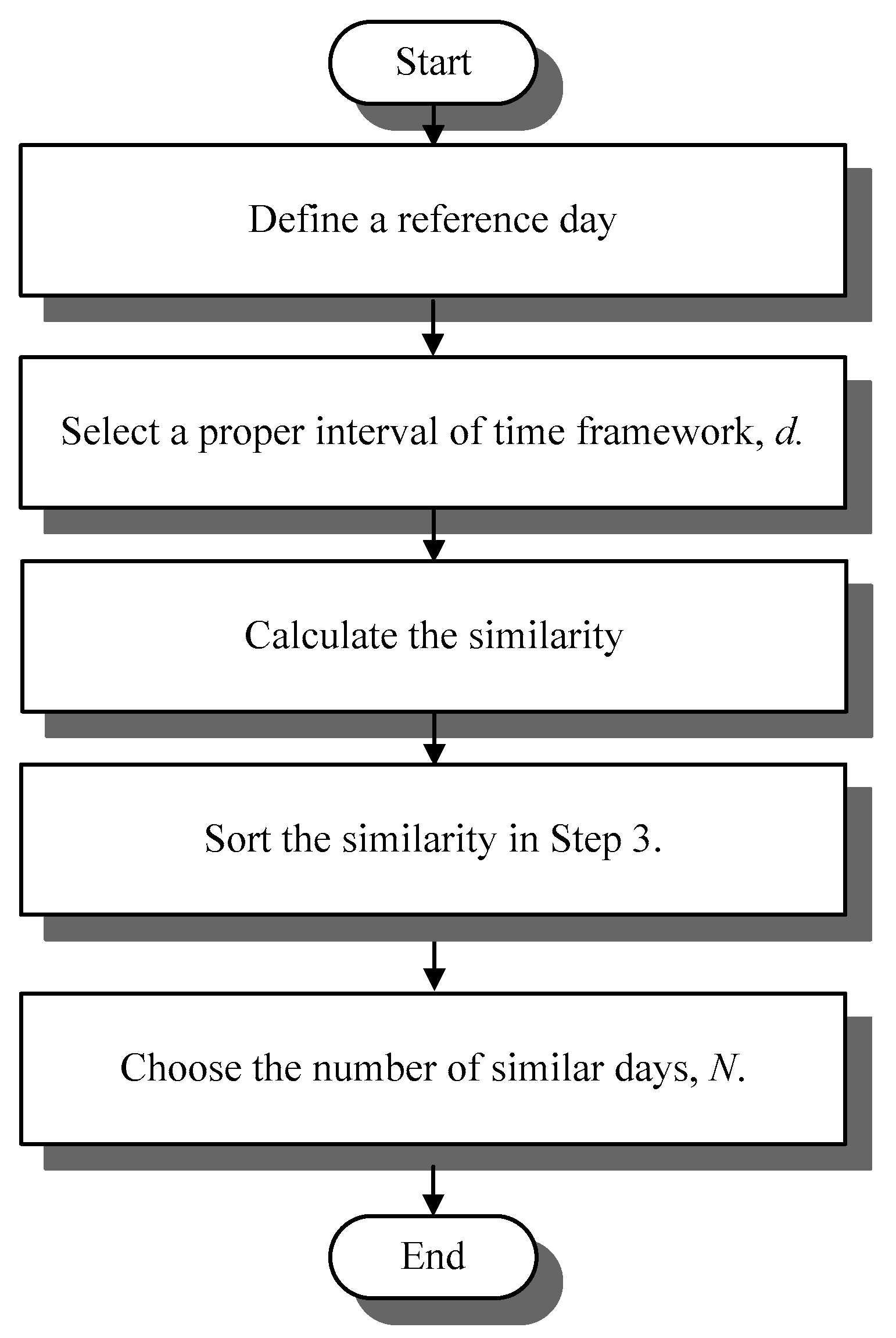

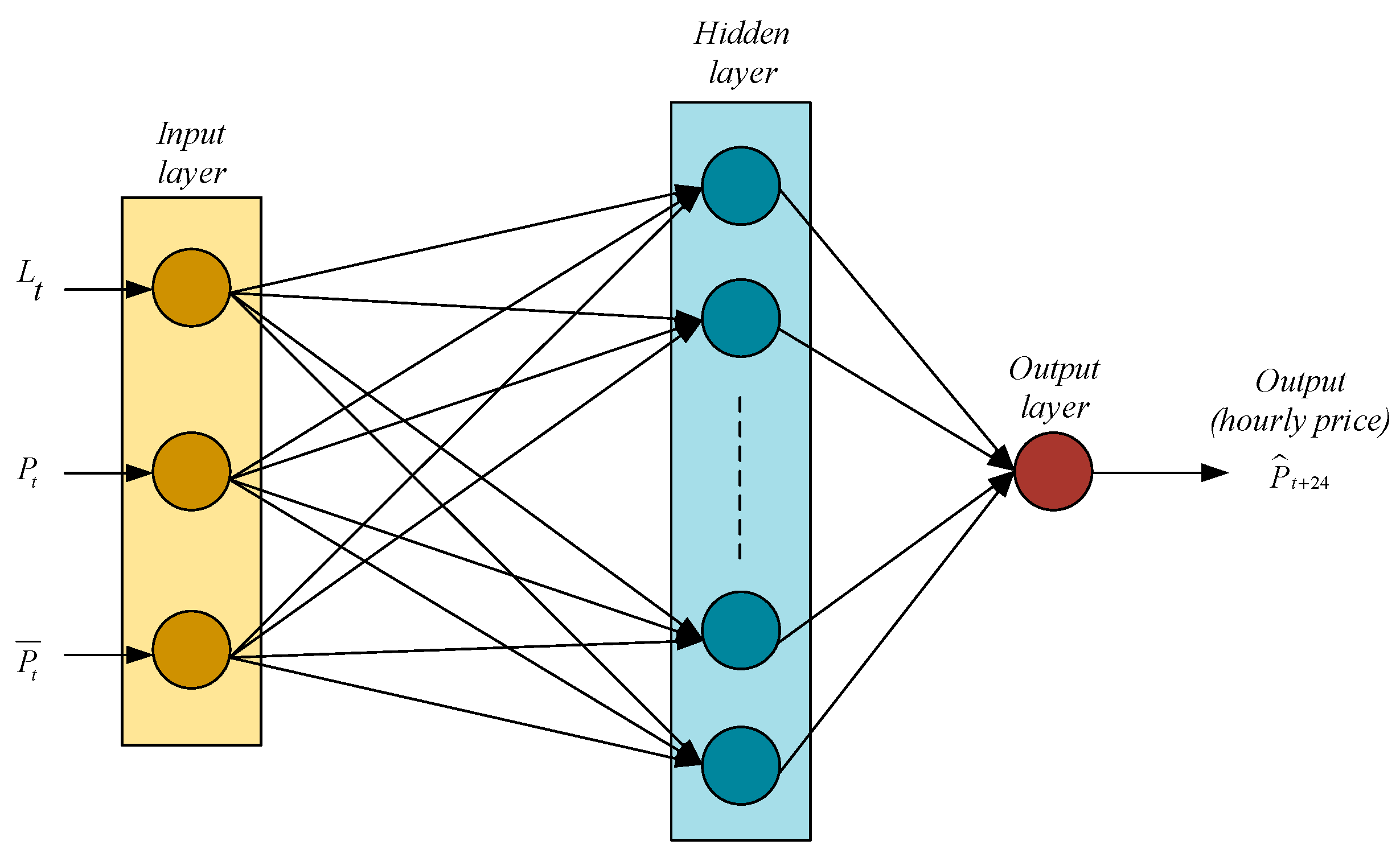
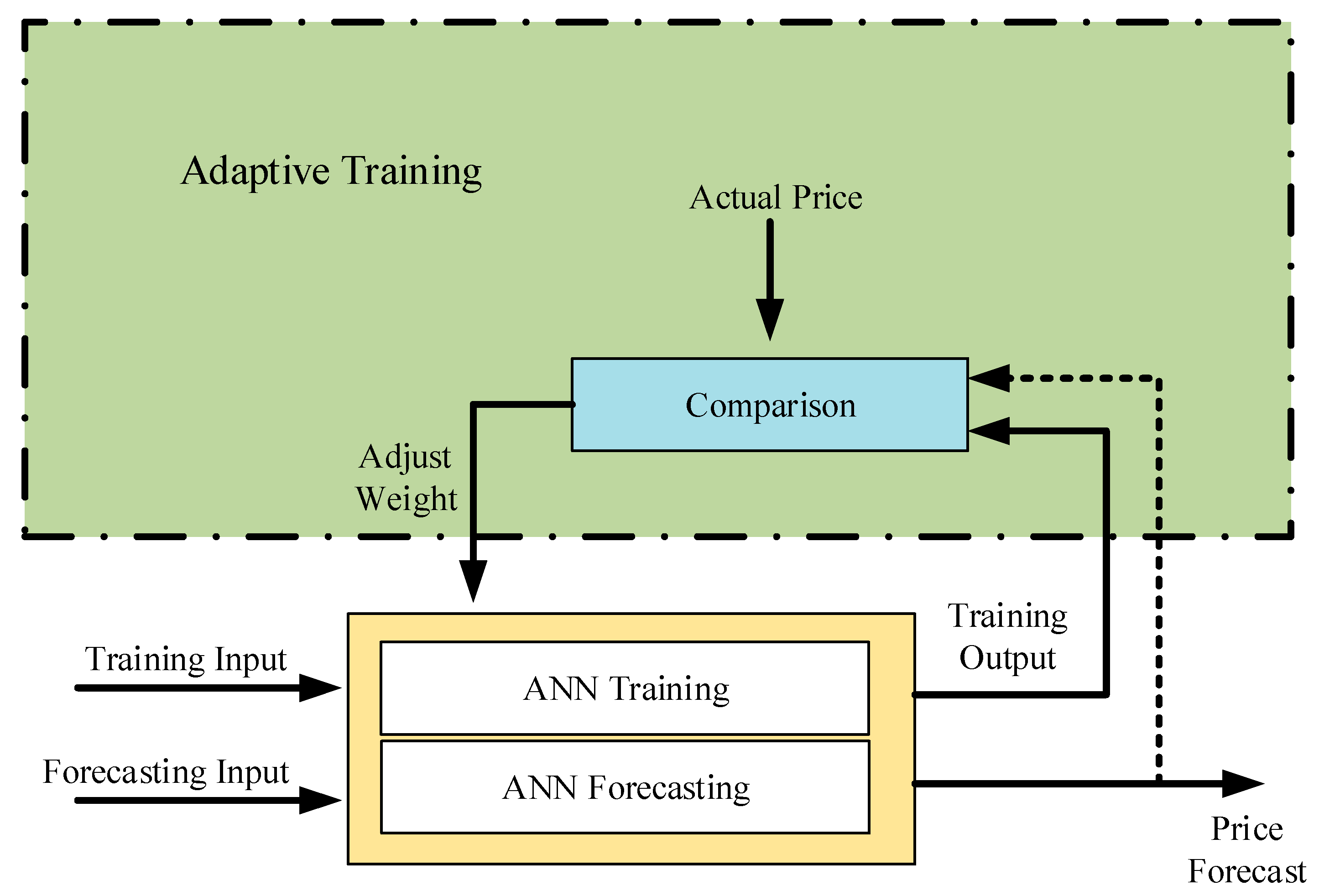

| Explanation | |
|---|---|
| Perfect correlation | |
| High degree of correlation | |
| Moderate degree of correlation | |
| Low degree of correlation | |
| No correlation |
| 20 January 2006 | ||||||||||||
|---|---|---|---|---|---|---|---|---|---|---|---|---|
| MAPE | d = 15 | d = 30 | d = 45 | d = 60 | ||||||||
| ANN | N = 3 | N = 5 | N = 10 | N = 3 | N = 5 | N = 10 | N = 3 | N = 5 | N = 10 | N = 3 | N = 5 | N = 10 |
| Model A (%) | 8.64 | 8.32 | 8.23 | 9.62 | 8.03 | 8.46 | 10.13 | 14.96 | 13.51 | 7.69 | 8.41 | 8.33 |
| Model B (%) | 8.80 | 8.18 | 7.85 | 12.13 | 9.97 | 8.46 | 13.63 | 9.02 | 14.53 | 9.69 | 9.86 | 9.76 |
| Model C (%) | 13.11 | 12.70 | 10.21 | 10.91 | 11.19 | 9.62 | 10.16 | 19.27 | 13.16 | 11.31 | 14.87 | 13.71 |
| Model D (%) | 12.76 | 14.77 | 14.13 | 10.73 | 11.16 | 12.57 | 8.10 | 8.39 | 10.57 | 9.69 | 8.48 | 10.76 |
| 10 February 2006 | ||||||||||||
| MAPE | d = 15 | d = 30 | d = 45 | d = 60 | ||||||||
| ANN | N = 3 | N = 5 | N = 10 | N = 3 | N = 5 | N = 10 | N = 3 | N = 5 | N = 10 | N = 3 | N = 5 | N = 10 |
| Model A (%) | 11.06 | 12.67 | 10.69 | 11.51 | 11.28 | 11.07 | 10.48 | 11.74 | 10.22 | 12.12 | 11.99 | 11.35 |
| Model B (%) | 11.05 | 11.84 | 12.27 | 11.13 | 11.28 | 11.01 | 10.04 | 11.28 | 11.19 | 12.06 | 11.66 | 11.55 |
| Model C (%) | 11.50 | 11.66 | 11.32 | 10.46 | 11.51 | 11.26 | 9.67 | 10.20 | 11.81 | 10.96 | 10.89 | 11.07 |
| Model D (%) | 9.19 | 11.04 | 13.10 | 9.37 | 10.22 | 10.61 | 8.93 | 9.54 | 11.31 | 11.46 | 10.09 | 11.79 |
| 5 March 2006 | ||||||||||||
| MAPE | d = 15 | d = 30 | d = 45 | d = 60 | ||||||||
| ANN | N = 3 | N = 5 | N = 10 | N = 3 | N = 5 | N = 10 | N = 3 | N = 5 | N = 10 | N = 3 | N = 5 | N = 10 |
| Model A (%) | 7.84 | 9.65 | 9.54 | 9.07 | 9.44 | 8.71 | 9.67 | 7.68 | 8.57 | 6.57 | 6.66 | 7.95 |
| Model B (%) | 9.99 | 11.32 | 9.75 | 9.34 | 9.44 | 8.70 | 10.67 | 7.64 | 8.11 | 8.03 | 6.89 | 7.95 |
| Model C (%) | 11.41 | 12.21 | 14.81 | 10.89 | 12.94 | 14.24 | 11.10 | 9.81 | 9.21 | 11.65 | 9.90 | 6.62 |
| Model D (%) | 8.14 | 7.24 | 7.76 | 8.33 | 7.31 | 8.22 | 6.21 | 6.41 | 7.74 | 6.81 | 6.63 | 8.15 |
| 7 April 2006 | ||||||||||||
| MAPE | d = 15 | d = 30 | d = 45 | d = 60 | ||||||||
| ANN | N = 3 | N = 5 | N = 10 | N = 3 | N = 5 | N = 10 | N = 3 | N = 5 | N = 10 | N = 3 | N = 5 | N = 10 |
| Model A (%) | 10.17 | 10.07 | 9.25 | 11.47 | 11.36 | 11.56 | 12.68 | 15.21 | 12.68 | 11.95 | 11.73 | 12.31 |
| Model B (%) | 9.44 | 10.07 | 10.62 | 10.70 | 11.36 | 11.29 | 11.98 | 11.71 | 10.90 | 12.28 | 10.05 | 11.37 |
| Model C (%) | 9.05 | 8.36 | 8.45 | 9.49 | 9.73 | 8.34 | 10.08 | 12.67 | 12.74 | 11.73 | 12.93 | 12.04 |
| Model D (%) | 11.78 | 9.82 | 10.43 | 12.56 | 12.69 | 11.52 | 12.54 | 13.09 | 13.12 | 12.03 | 13.42 | 13.09 |
| 13 May 2006 | ||||||||||||
| MAPE | d = 15 | d = 30 | d = 45 | d = 60 | ||||||||
| ANN | N = 3 | N = 5 | N = 10 | N = 3 | N = 5 | N = 10 | N = 3 | N = 5 | N = 10 | N = 3 | N = 5 | N = 10 |
| Model A (%) | 16.78 | 17.34 | 19.70 | 16.99 | 18.34 | 19.07 | 11.57 | 14.82 | 13.51 | 16.76 | 18.16 | 19.54 |
| Model B (%) | 14.40 | 12.44 | 16.43 | 16.48 | 16.98 | 18.65 | 11.63 | 14.81 | 16.31 | 15.23 | 16.23 | 17.97 |
| Model C (%) | 11.78 | 7.85 | 9.14 | 11.59 | 9.99 | 9.50 | 11.63 | 13.41 | 14.71 | 13.62 | 11.93 | 17.03 |
| Model D (%) | 8.34 | 9.88 | 15.37 | 10.19 | 11.59 | 15.24 | 11.29 | 13.67 | 14.08 | 11.38 | 13.77 | 14.17 |
| MAPE | d = 15 | d = 30 | d = 45 | d = 60 | ||||||||
|---|---|---|---|---|---|---|---|---|---|---|---|---|
| RM | N = 3 | N = 5 | N = 10 | N = 3 | N = 5 | N = 10 | N = 3 | N = 5 | N = 10 | N = 3 | N = 5 | N = 10 |
| Model A (%) | 10.90 | 11.61 | 11.48 | 11.73 | 11.69 | 11.77 | 10.91 | 12.88 | 11.70 | 11.02 | 11.39 | 11.90 |
| Model B (%) | 10.74 | 10.77 | 11.38 | 11.96 | 11.81 | 11.62 | 11.59 | 10.89 | 12.21 | 11.46 | 10.94 | 11.72 |
| Model C (%) | 11.37 | 10.56 | 10.79 | 10.67 | 11.07 | 10.59 | 10.53 | 13.07 | 12.33 | 11.85 | 12.10 | 12.09 |
| Model D (%) | 10.04 | 10.55 | 12.16 | 10.24 | 10.59 | 11.63 | 9.41 | 10.22 | 11.36 | 10.27 | 10.48 | 11.59 |
| 20 January 2006 | ||||||||||||
|---|---|---|---|---|---|---|---|---|---|---|---|---|
| MAPE | d = 15 | d = 30 | d = 45 | d = 60 | ||||||||
| ANN | N = 3 | N = 5 | N = 10 | N = 3 | N = 5 | N = 10 | N = 3 | N = 5 | N = 10 | N = 3 | N = 5 | N = 10 |
| Model A (%) | 7.29 | 7.55 | 6.35 | 7.23 | 5.65 | 5.83 | 6.47 | 6.83 | 6.67 | 5.83 | 6.55 | 5.83 |
| Model B (%) | 7.25 | 7.84 | 6.96 | 7.11 | 6.73 | 5.95 | 5.49 | 7.36 | 5.28 | 7.14 | 6.98 | 6.75 |
| Model C (%) | 9.77 | 9.12 | 8.39 | 7.20 | 7.01 | 7.15 | 6.10 | 5.90 | 6.21 | 4.33 | 7.97 | 7.03 |
| Model D (%) | 6.30 | 6.57 | 6.49 | 6.04 | 4.46 | 6.17 | 5.66 | 6.09 | 7.31 | 4.39 | 5.01 | 6.44 |
| 10 February 2006 | ||||||||||||
| MAPE | d = 15 | d = 30 | d = 45 | d = 60 | ||||||||
| ANN | N = 3 | N = 5 | N = 10 | N = 3 | N = 5 | N = 10 | N = 3 | N = 5 | N = 10 | N = 3 | N = 5 | N = 10 |
| Model A (%) | 7.06 | 7.43 | 8.16 | 7.47 | 8.24 | 8.46 | 7.91 | 9.13 | 8.94 | 8.70 | 9.56 | 9.31 |
| Model B (%) | 6.93 | 7.38 | 7.68 | 7.51 | 8.68 | 8.52 | 7.91 | 8.53 | 7.79 | 8.56 | 9.77 | 9.91 |
| Model C (%) | 6.98 | 7.36 | 7.72 | 7.42 | 8.77 | 8.75 | 7.38 | 7.69 | 8.17 | 8.25 | 9.03 | 8.58 |
| Model D (%) | 5.96 | 7.25 | 8.21 | 6.72 | 7.41 | 9.89 | 6.13 | 7.14 | 9.42 | 7.47 | 8.88 | 7.62 |
| 5 March 2006 | ||||||||||||
| MAPE | d = 15 | d = 30 | d = 45 | d = 60 | ||||||||
| ANN | N = 3 | N = 5 | N = 10 | N = 3 | N = 5 | N = 10 | N = 3 | N = 5 | N = 10 | N = 3 | N = 5 | N = 10 |
| Model A (%) | 6.97 | 7.10 | 7.48 | 7.42 | 7.54 | 8.23 | 8.38 | 7.61 | 9.91 | 7.82 | 8.23 | 8.32 |
| Model B (%) | 6.97 | 7.19 | 7.58 | 7.14 | 7.66 | 8.88 | 5.82 | 5.27 | 5.26 | 8.24 | 8.34 | 8.16 |
| Model C (%) | 8.21 | 8.87 | 9.45 | 8.40 | 8.89 | 9.93 | 4.99 | 4.79 | 5.52 | 8.99 | 9.19 | 8.23 |
| Model D (%) | 6.56 | 6.62 | 7.41 | 5.45 | 7.08 | 8.24 | 5.03 | 5.55 | 7.48 | 6.73 | 5.90 | 7.69 |
| 7 April 2006 | ||||||||||||
| MAPE | d = 15 | d = 30 | d = 45 | d = 60 | ||||||||
| ANN | N = 3 | N = 5 | N = 10 | N = 3 | N = 5 | N = 10 | N = 3 | N = 5 | N = 10 | N = 3 | N = 5 | N = 10 |
| Model A (%) | 7.17 | 7.06 | 6.63 | 5.78 | 5.89 | 5.22 | 9.19 | 9.31 | 6.07 | 6.39 | 6.64 | 5.42 |
| Model B (%) | 6.81 | 7.22 | 7.10 | 6.25 | 5.87 | 4.93 | 9.19 | 6.14 | 5.74 | 6.53 | 5.91 | 5.02 |
| Model C (%) | 7.07 | 6.63 | 6.47 | 5.85 | 5.69 | 6.05 | 6.67 | 7.22 | 6.29 | 7.09 | 7.64 | 5.53 |
| Model D (%) | 7.13 | 7.05 | 6.95 | 5.27 | 6.19 | 5.27 | 6.15 | 6.35 | 6.40 | 7.35 | 6.84 | 5.28 |
| 13 May 2006 | ||||||||||||
| MAPE | d = 15 | d = 30 | d = 45 | d = 60 | ||||||||
| ANN | N = 3 | N = 5 | N = 10 | N = 3 | N = 5 | N = 10 | N = 3 | N = 5 | N = 10 | N = 3 | N = 5 | N = 10 |
| Model A (%) | 11.50 | 13.65 | 14.11 | 10.91 | 12.87 | 11.63 | 5.08 | 7.67 | 5.43 | 10.35 | 9.78 | 9.73 |
| Model B (%) | 16.09 | 13.47 | 15.38 | 8.65 | 10.25 | 8.54 | 6.60 | 10.34 | 6.23 | 8.96 | 8.73 | 10.24 |
| Model C (%) | 9.05 | 8.05 | 8.87 | 6.46 | 6.22 | 5.27 | 5.85 | 7.44 | 6.88 | 9.27 | 6.71 | 7.28 |
| Model D (%) | 6.71 | 8.33 | 9.19 | 4.99 | 5.34 | 8.42 | 4.67 | 6.24 | 7.28 | 7.92 | 6.95 | 6.19 |
| MAPE | d = 15 | d = 30 | d = 45 | d = 60 | ||||||||
|---|---|---|---|---|---|---|---|---|---|---|---|---|
| ANN | N = 3 | N = 5 | N = 10 | N = 3 | N = 5 | N = 10 | N = 3 | N = 5 | N = 10 | N = 3 | N = 5 | N = 10 |
| Model A (%) | 8.00 | 8.56 | 8.55 | 7.76 | 8.04 | 7.87 | 7.41 | 8.11 | 7.40 | 7.82 | 8.15 | 7.72 |
| Model B (%) | 8.81 | 8.62 | 8.94 | 7.33 | 7.84 | 7.36 | 7.00 | 7.53 | 6.06 | 7.89 | 7.95 | 8.02 |
| Model C (%) | 8.22 | 8.01 | 8.18 | 7.07 | 7.32 | 7.43 | 6.20 | 6.61 | 6.61 | 7.59 | 8.11 | 7.33 |
| Model D (%) | 6.53 | 7.16 | 7.65 | 5.69 | 6.10 | 7.60 | 5.53 | 6.28 | 7.58 | 6.77 | 6.72 | 6.64 |
| Method | RM | ANN | Deviation | |||
|---|---|---|---|---|---|---|
| MAPE (%) | FMSE ($/MWh) | MAPE (%) | FMSE ($/MWh) | MAPE (%) | FMSE ($/MWh) | |
| January 20 | 8.10 | 5.397 | 5.66 | 4.232 | 2.44 | 1.165 |
| February 10 | 8.93 | 7.153 | 6.13 | 4.382 | 2.80 | 2.771 |
| March 5 | 6.21 | 3.429 | 5.03 | 2.820 | 1.18 | 0.609 |
| April 7 | 12.53 | 8.117 | 6.15 | 3.787 | 6.38 | 4.33 |
| May 13 | 11.29 | 5.203 | 4.67 | 2.138 | 6.62 | 3.065 |
| Average | 9.41 | 5.860 | 5.53 | 3.472 | 3.88 | 2.388 |
© 2020 by the authors. Licensee MDPI, Basel, Switzerland. This article is an open access article distributed under the terms and conditions of the Creative Commons Attribution (CC BY) license (http://creativecommons.org/licenses/by/4.0/).
Share and Cite
Lee, C.-Y.; Wu, C.-E. Short-Term Electricity Price Forecasting Based on Similar Day-Based Neural Network. Energies 2020, 13, 4408. https://doi.org/10.3390/en13174408
Lee C-Y, Wu C-E. Short-Term Electricity Price Forecasting Based on Similar Day-Based Neural Network. Energies. 2020; 13(17):4408. https://doi.org/10.3390/en13174408
Chicago/Turabian StyleLee, Chun-Yao, and Chang-En Wu. 2020. "Short-Term Electricity Price Forecasting Based on Similar Day-Based Neural Network" Energies 13, no. 17: 4408. https://doi.org/10.3390/en13174408
APA StyleLee, C.-Y., & Wu, C.-E. (2020). Short-Term Electricity Price Forecasting Based on Similar Day-Based Neural Network. Energies, 13(17), 4408. https://doi.org/10.3390/en13174408



